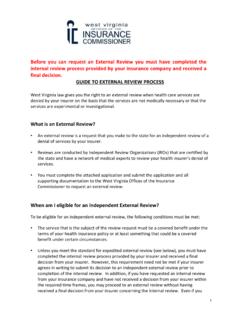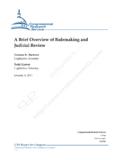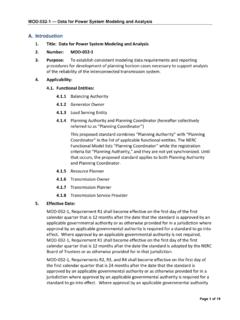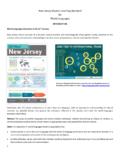Transcription of The WHO Vaccine Strain Selection Process: Review …
1 The WHO Vaccine Strain Selection process : Review of the evidence Jacqueline Katz, PhD Influenza Division Centers for Disease Control and Prevention WHO Collaborating Center for Surveillance, Epidemiology and Control of Influenza WHO Vaccine Strain Selection process for Seasonal Influenza Complex, year around virological surveillance is conducted by the Global Influenza Surveillance and Response System (GISRS) WHOCCs, NICs, ERLs, H5 Reference Laboratories Two annual WHO Consultations for N. and S. Hemisphere (Feb and Sept, respectively) Review , analyse and summarize data and make recommendation within 3 days Communicated to Industry and summary posted on WHO website WHO s Global Influenza Surveillance and Response Network National Influenza Centers (NICs) ( 140 Laboratories in 110 Countries) World Health Organization (Geneva) Vaccine Producers International Collaborating Centers (Atlanta, London, Melbourne, Tokyo and Beijing)
2 Isolate influenza viruses Identify viruses and send to International Collaborating Center(s) Collect epidemiologic information Collect information for the Weekly Epidemiological Record and WWW for distribution Make annual Vaccine recommendations Analyze influenza viruses received Provide data for annual Vaccine Strain recommendations Prepare and distribute candidate Vaccine strains and reagents 0 200 400 600 800 1000 40 42 44 46 48 50 52 02 04 06 08 10 12 14 16 18 20 H1N1 B H3N2 Week Time is a Major Constraint Respiratory Specimens Positive for Influenza in the US and Vaccine Selection .
3 2007-08 Vaccine production WHO Influenza Vaccine Virus Recommendations February - N. Hemisphere & September - S. Hemisphere Are there new antigenic variants? Antigenic (HAI and VNT) and genetic characterization Are new variants spreading? Monitoring influenza disease activity and virus isolation Are current vaccines able to induce antibodies to the new variants? Serological evaluation of vaccinated individuals Are any new variants useful for Vaccine production? Substrate for virus isolation (egg isolates required now) High growth reassortants needed Considerations for New Vaccine Recommendations A(H3N2) Viruses Sept 2011 Feb 2012 GISRS: Percentage of influenza viruses by subtypes (From 4 September 2011 28 January 2012) Data source: FluNet, ( ), Global Influenza Surveillance and Response System (13 February 2012) Number of A(H3N2) viruses detected by GISRS 01,0002,0003,000159131721252933374145495 3 Week of the year201020112012 Data source.
4 FluNet, ( ), Global Influenza Surveillance and Response System (13 February 2012) H3N2 viruses characterized during the past 2 Northern Hemisphere seasons 0100200300400500600 CDCCNICNIIDNIMRVIDRLSept 2010 to Jan 2011 Sept 2011 to Jan 2012 Hemagglutinin Focused Virological Surveillance Virus entry and infection Host restriction / species barrier Main antigenic target for immune system Antigenic drift on H3 seasonal influenza strains Mutation rate random but selective ~ amino acid residues per year Genetic changes may effect.
5 Antigenic drift Strucure and receptor specificity Immune escape/ Vaccine Effectiveness Glycosylation RBS Carbohydrates Antigenic drift TM WHO test of choice Reliable, relatively simple and inexpensive Fast: A few hours to perform Many viruses can be tested relatively quickly Based on the binding of antibodies to HA Proper virus titration is essential for analysis Requires characterized set of reference viruses and ferret antisera Hemagglutination Inhibition (HAI) Test No inhibition HA inhibition TM Antigenic Characterization Using HAI Testing.
6 Older Example of a New Antigenic Variant DateREFERENCE ANTIGENSBR/10UR/716 VIC/208 PERTH/16HK/26560collected1A/BRISBANE/10/ 20071280128040208026/06/072A/URUGUAY/716 /2007128025602020206/21/20073A/VICTORIA/ 208/20098010128032012806/2/20094A/PERTH/ 16/200910<103203206404/7/20095A/HONG KONG/26560/200910<103201606409/18/2009 REFERENCE FERRET ANTISERAHAI titers demonstrate a 2-way 8-fold reduction in titers between Brisbane/10/2007-like and Perth/16/2009-like viruses HI Reactions of Influenza A(H3N2) Viruses (Guinea Pig Red Blood Cells; 2-12-12) BR I S/ 10 PER T H / 1615 HAD ateR EFER EN CE AN T I GEN SBR / 10 PER / 16BA/ 5071S.
7 AS/ 3T H / 277OR / 9MT / 5N Z / 28BR / 299KY/ 5groupcollectedPassage1A/ BR I SBAN E/ 10/ 200732040808080408040208002/ 06/ 07E2/ E22A/ PER T H / 16/ 2009* 20640160640320160640320320640104/ 07/ 09E3/ E23A/ BAN GLAD ESH / 5071/ 2011* 80803206403203201603203203203B05/ 19/ 11CX/ C24A/ SOU T H AU ST R ALI A/ 03/ 2011* 401603203203201601601603203203C06/ 10/ 11C2/ C25A/ CH I AN G R AI / 277/ 2011* 208020160320808016080803C09/ 20/ 11C1/ C26A/ OR EGON / 09/ 2011 4080401601601601601601601603C10/ 27/ 11M1/ C27A/ MON T AN A/ 05/ 20115804016016080320160160320503/ 02/ 11E28A/ CH R I ST CH U R CH / 28/ 2011*5160160320320160320640320640608/ 05/ 11E5/ E29A/ BR I SBAN E/ 299/ 2011 40160808016016032016016080608/ 13/ 11C4/ C210A/ KEN T U CKY/ 05/ 2011* 10802016016080160320160160611/ 04/ 11X1/ C2T EST AN T I GEN S11A/ MI SSI SSI PPI / 02/ 2012103203201280128064032032064064001/ 12/ 12C212A/ T EXAS/ 13/ 20128032016064064032064064064064001/ 18/ 12C213A/ CALI FOR N I A/ 01/ 201240804016016080160160320160501/ 04/ 12C214A/ COLOR AD O/ 05/
8 2012208020160160160160801608001/ 11/ 12C115A/ FLOR I D A/ 02/ 2012208080160160160160160320160601/ 09/ 12C116A/ I OW A/ 04/ 201220804016016080801608016001/ 13/ 12C217A/ KEN T U CKY/ 05/ 2011580801601601603208016080611/ 04/ 11N C2E518A/ OR EGON / 01/ 2012808016032016016016016032032001/ 04/ 12M1/ C219A/ T EXAS/ 06/ 2012408080160320160320320320320601/ 05/ 12M1/ C120A/ W YOMI N G/ 01/ 20122080401601608016016016080601/ 10/ 12C221A/ I OW A/ 01/ 20122040208016080801601601603B01/ 03/ 12C222A/ I OW A/ 05/ 2012104040801608080801608001/ 18/ 12C223A/ N EBR ASKA/ 01/ 2012204040808080808080803B01/ 14/ 12C124A/ T EXAS/ 10/ 2012104040808080808080803C01/ 16/ 12C225A/ VI R GI N I A/ 03/ 2012204020160160801608080803C01/ 23/ 12M1/ C126A/ W ASH I N GT ON / 05/ 201210404080808040801608001/ 11/ 12C127A/ CALI FOR N I A/ 09/ 20121020204080404080804001/ 18/ 12C128A/ BR I T I SH COLU MBI A/ 4791/ 2011408040320160160160160160803B12/ 13/ 11X1/ C129A/ SASKAT CH EW AN / R V0019/ 2011408040160160160808080803B12/ 20/ 11X1/ C130A/ AST R AKH
9 AN / 65/ 20111603206406406406406406406406403B12/ 15/ 11C3/ C131A/ EN GLAN D / 258/ 201120804016016080160160160403C11/ 07/ 11S1S1/ C132A/ BR I SBAN E/ 299/ 2011 I VR -16456406401280128032025606403206403CR EASSEX/ E133A/ BR I SBAN E/ 299/ 2011 53203206406403206406406406403C08/ 13/ 11E5/ E434A/ H ON G KON G/ 4913/ 201120402080160808016080803C11/ 29/ 11C3/ C135A/ KEN YA/ 7503/ 2011201608032032016032032032064011/ 22/ 11C1/ C1 Sequence in GI SAI D*Serology antigen36VI C/ 208R EFER EN CE FER R ET AN T I SER AInfluenza A(H3N2) Isolates Characterized by CDC North America Europe Asia Cent/So America Africa, Australia, New Zealand Total (%) September 2010 February 2011 A/Perth/16/2009-like* 743 21 3 105 61 28 961 (65%) A/Perth/16/2009-like** 332 34 2 54 33 12 467 (32%) A/Perth/16/2009-like (low)** 38 6 1 2 2 49 (3%) Total 1477 March 2011 August 2011 A/Perth/16/2009-like* 190 3 1 43 163 17 417 (76%) A/Perth/16/2009-like** 58 1 2 21 46 128 (23%) A/Perth/16/2009-like (low)** 3 1 4 (1%)
10 Total 549 September 2011 February 2012 A/Perth/16/2009-like* 134 1 2 16 10 3 166 (37%) A/Perth/16/2009-like** 160 26 10 13 209 (46%) A/Perth/16/2009-like (low)** 57 4 1 8 6 76 (17%) Total 451 Total 1715 70 12 275 325 80 2477 * < 4-fold low to Vaccine Strain Preliminary Data 02/23/2012 ** = 4-fold low to Vaccine Strain ** 8-fold low to Vaccine Strain HA genetic group16 HADATEVIRUSESPER/16/09S. AUS/03/11TH/277/11KY/05/11 AUSTRALIA/03/201164025601280256032011-06 -105A/CHIANG RAI

















